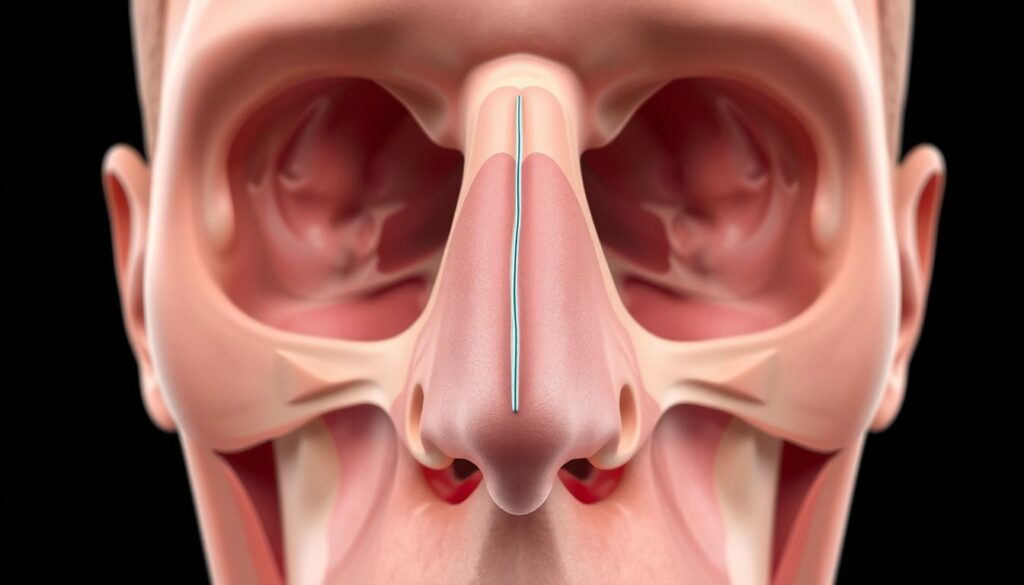A deviated septum can cause significant health issues, including breathing difficulties and chronic nasal congestion. Septoplasty, a surgical procedure to correct this condition, is often sought by individuals looking to improve their quality of life.
Many patients wonder if their insurance will cover this surgery. The answer depends on several factors, including the severity of the deviated septum and the specific terms of the patient’s insurance policy.
In Florida, insurance coverage for septoplasty varies. Understanding the medical necessity of the procedure and the associated costs is crucial for patients considering this surgery.
Key Takeaways
- Septoplasty is a surgical procedure to correct a deviated septum, improving breathing and health.
- Insurance coverage for septoplasty in Florida depends on the severity of the condition and policy terms.
- Understanding medical necessity and costs is crucial for patients.
- Septoplasty is distinct from cosmetic nasal surgeries.
- Insurance policies vary in their coverage of septoplasty.
Understanding Septoplasty and Deviated Septum
The connection between septoplasty and a deviated septum is vital to understand for individuals dealing with chronic breathing problems. A deviated septum is a condition where the thin wall of cartilage and bone between the two sides of the nasal passages is displaced, making one nasal passage smaller than the other.
What Is a Deviated Septum?
A deviated septum can occur due to genetics, injury, or developmental issues during fetal development. The nasal septum is the partition that separates the right and left sides of the nasal chamber. When this partition is off-center, it can cause breathing difficulties and other health issues.

How a Deviated Septum Affects Your Health
A deviated septum can lead to various health problems, including snoring and sleep apnea. It can also cause chronic sinusitis and recurrent sinus infections due to improper drainage. The table below summarizes the primary health impacts of a deviated septum.
| Health Issue | Description |
|---|---|
| Breathing Difficulties | Restricted airflow can affect daily life and overall well-being. |
| Chronic Sinusitis | Improper drainage can lead to recurrent sinus infections. |
| Sleep Disturbances | Snoring and sleep apnea can result from a deviated septum. |
Septoplasty vs. Rhinoplasty: Key Differences
Septoplasty and rhinoplasty are two distinct surgical procedures that address different nasal concerns. While both procedures involve surgery on the nose, they have different objectives and outcomes.
Septoplasty is primarily focused on correcting a deviated septum to improve breathing and nasal function. On the other hand, rhinoplasty is a cosmetic procedure aimed at reshaping the nose to enhance its appearance. Understanding the differences between these procedures is crucial for individuals considering nasal surgery.
Functional vs. Cosmetic Procedures
The primary distinction between septoplasty and rhinoplasty lies in their purpose. Septoplasty is a functional procedure that aims to correct nasal obstruction and improve breathing. In contrast, rhinoplasty is typically considered a cosmetic procedure, as it is designed to alter the appearance of the nose.
However, it’s worth noting that rhinoplasty can also have functional benefits, such as correcting nasal deformities that may be causing breathing difficulties.
Combined Procedures: When Both Are Necessary
In some cases, patients may benefit from undergoing both septoplasty and rhinoplasty. This combined procedure, known as septorhinoplasty, addresses both functional and aesthetic concerns simultaneously. By correcting the deviated septum and reshaping the nose, patients can achieve improved breathing and a more aesthetically pleasing nasal appearance.
When both procedures are necessary, surgeons will typically work to maintain the structural integrity of the nose while achieving the desired aesthetic goals.
Is Septoplasty Covered by Insurance in FL?
Septoplasty, a surgical procedure to correct a deviated septum, may be covered by insurance in Florida under certain conditions. Insurance coverage for septoplasty depends on the medical necessity of the procedure.

Medical Necessity Requirements
To qualify for insurance coverage, patients must demonstrate that septoplasty is medically necessary. This typically involves documenting symptoms such as significant nasal obstruction, chronic sinusitis, or other related health issues.
Key factors that establish medical necessity include:
- Failed conservative treatments (e.g., medications, nasal strips)
- Diagnostic test results (e.g., nasal endoscopy, CT scans)
- A detailed letter from the surgeon justifying the medical need for septoplasty
Documentation Needed for Insurance Approval
To secure insurance approval, comprehensive documentation is required. This includes:
- Medical records detailing the patient’s condition and symptoms
- Results from diagnostic tests confirming the presence and severity of a deviated septum
- Specialist evaluations supporting the need for surgical intervention
Working with a surgeon’s office experienced in navigating insurance approvals can significantly impact the success of the claim. It’s also crucial to understand the process of submitting documentation and what to expect during the review period.
The Septoplasty Procedure Explained
If you’re considering septoplasty, it’s essential to understand the procedure and what to expect during recovery. Septoplasty is a surgical operation to correct a deviated septum, which can significantly improve the quality of life for individuals suffering from breathing difficulties.
Surgical Techniques and Process
The septoplasty procedure involves several key steps. First, the surgeon makes an incision in the nose to access the septum. The deviated portions of the septum are then removed or repositioned to improve airflow. The procedure is typically performed under general anesthesia or local anesthesia with sedation. Modern facial plastic surgery techniques aim to minimize swelling and pain during and after the surgery.
What to Expect During Recovery
During the recovery period, patients can expect some swelling and pain around the nose. These symptoms typically subside within a few weeks. To ensure optimal results, it’s crucial to follow post-operative instructions, including nasal cleaning, medication management, and activity restrictions. Most patients can return to their normal activities within a week or two. However, it may take several months for the final results of the septoplasty to become apparent as the swelling fully subsides.
Cost of Septoplasty in Florida
The financial aspects of septoplasty in Florida can be complex, involving multiple components. Understanding these costs is crucial for patients to make informed decisions about their healthcare.
Average Costs With Insurance Coverage
The average cost of septoplasty with insurance coverage varies. Insurance typically covers a significant portion of the procedure when deemed medically necessary. Patients should expect to pay deductibles and copays. The cost can range based on the procedure’s complexity and the surgeon’s fees.
Out-of-Pocket Expenses to Consider
Patients should budget for out-of-pocket expenses, including prescription medications, follow-up visits, and potential time off work. The cost of septoplasty can also be influenced by the surgeon’s experience and the procedure’s complexity. Additionally, facial plastic surgery costs vary across Florida, with major metropolitan areas typically charging more than smaller communities.
When comparing septoplasty to rhinoplasty, patients should understand that while both are surgery procedures, their costs and purposes differ. Septoplasty is generally more affordable since it’s primarily functional, whereas rhinoplasty is often cosmetic. Combining both procedures can affect overall costs, with patients typically responsible for the cosmetic portion.
Financing Options for Septoplasty
Exploring financing options for septoplasty can help patients in Florida manage the costs associated with the procedure. Septoplasty, a surgical procedure to correct a deviated septum, can be costly, but various financing options can make it more affordable.
Payment Plans and Medical Credit Cards
Many healthcare providers offer payment plans that allow patients to pay for septoplasty in installments. These plans can vary, so it’s essential to discuss the details with your provider. Additionally, medical credit cards are another financing option. They offer a way to cover the procedure’s cost and can be paid off over time, often with promotional financing options like 0% interest.
HSA and FSA Options for Septoplasty
For patients with a Health Savings Account (HSA) or Flexible Spending Account (FSA), these can be used to pay for septoplasty if deemed medically necessary. It’s crucial to check with your provider to confirm what’s allowable. Using pre-tax dollars can help reduce the out-of-pocket expense. Understanding the annual contribution limits and the differences between HSAs and FSAs, including rollover provisions, is also important.
Conclusion: Making an Informed Decision About Septoplasty
As we conclude our exploration of septoplasty and its implications in Florida, it’s clear that understanding the nuances of this surgicalprocedureis crucial. Throughout this article, we’ve distinguishedseptoplastyfromrhinoplasty, highlighting their different purposes and insurance implications.
To make an informed decision, patients must confirm theirinsurancecoverage and understand the medical necessity requirements. Thecost of septoplastyin Florida varies, but financing options are available to help manage expenses. Selecting a qualified surgeon with experience ininsurance-covered proceduresis vital.
Correcting a deviated septum can significantly improvehealthandquality of lifeby enhancing breathing, reducing sinus infections, and promoting better sleep. I encourage readers to schedule aconsultationwith a qualified surgeon to discuss their specific situation and receive personalized advice. By investing in proper nasal function, individuals can experience lastingresultsand an improved overall well-being.
